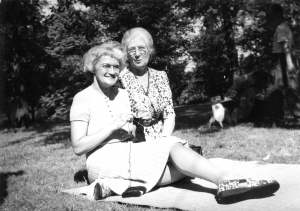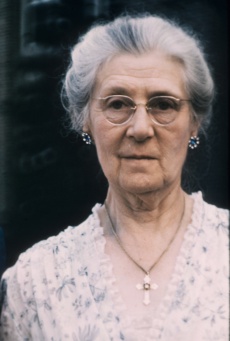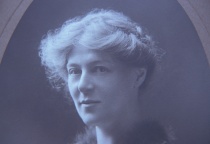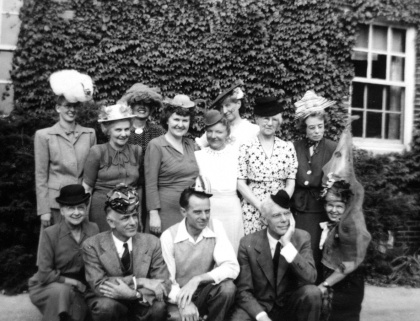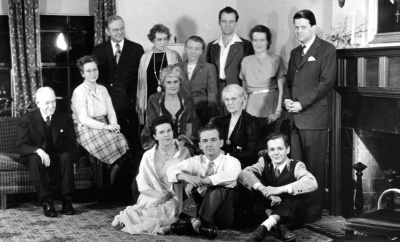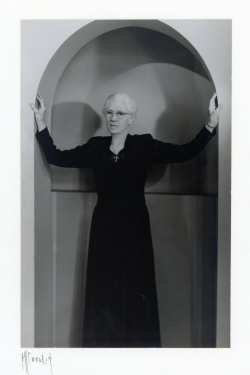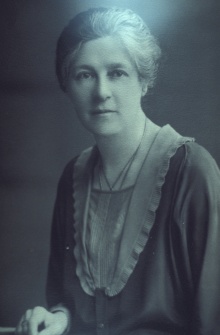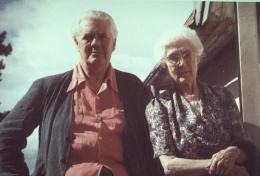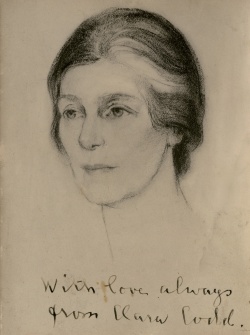Clara Codd: Difference between revisions
No edit summary |
|||
| (3 intermediate revisions by the same user not shown) | |||
| Line 19: | Line 19: | ||
</blockquote> | </blockquote> | ||
She was admitted to the French Section of the Theosophical Society at age 27, on December 16, 1903,<ref>The International Theosophical Year Book 1938 (Adyar, Madras, India: Theosophical Publishing House, 1938): 173.</ref> and attended a class for beginners. After a few more months in Switzerland, the family moved back to England - to Bath, in Somerset. Clara took a job as a governess in Ireland for some months, and on returning to Bath went to a meeting of the local Theosophical Society lodge. The lecturer was Bernard Old, a younger brother of [[Walter | She was admitted to the French Section of the Theosophical Society at age 27, on December 16, 1903,<ref>The International Theosophical Year Book 1938 (Adyar, Madras, India: Theosophical Publishing House, 1938): 173.</ref> and attended a class for beginners. After a few more months in Switzerland, the family moved back to England - to Bath, in Somerset. Clara took a job as a governess in Ireland for some months, and on returning to Bath went to a meeting of the local Theosophical Society lodge. The lecturer was Bernard Old, a younger brother of [[Walter Gornold|Walter Richard Old]] (later known as Walter Gornold or Sepharial]. The lodge president took Clara north to visit the Harrogate lodge and to meet [[Annie Besant]]. Her mother was also interested in Theosophy, and eventually all but one of her sisters became Theosophists. The family hosted visiting Theosophical lecturers such as A. W. Orage, who assisted Clara when she prepared to give her first talk to the lodge.<ref>Clara Codd, ''So Rich a Life'' (Pretoria: Institute for Theosophical Publicity, 1956), 10.</ref> | ||
[[File:Clara Codd 6.jpg|220px|thumb|Clara Codd]] | [[File:Clara Codd 6.jpg|220px|thumb|Clara Codd]] | ||
| Line 76: | Line 76: | ||
== Years in South Africa == | == Years in South Africa == | ||
[[File:Clara Codd by M Karklin.jpg|right|250px|thumb|Portrait by M. Karklin, Johannesburg]] | |||
=== 1938-1946 === | === 1938-1946 === | ||
| Line 235: | Line 236: | ||
* [http://www.theosophical.org/files/resources/Downloads/mp3/codd/Arcane%20Schools%20of%20Past%20and%20Future.mp3# Arcane Schools of Past and Future] by Clara Codd | * [http://www.theosophical.org/files/resources/Downloads/mp3/codd/Arcane%20Schools%20of%20Past%20and%20Future.mp3# Arcane Schools of Past and Future] by Clara Codd | ||
* [http://www.theosophical.org/files/resources/Downloads/mp3/codd/Life%20on%20the%20Other%20Side%20of%20Death.mp3# Life on the Other Side of Death] by Clara Codd | * [http://www.theosophical.org/files/resources/Downloads/mp3/codd/Life%20on%20the%20Other%20Side%20of%20Death.mp3# Life on the Other Side of Death] by Clara Codd | ||
* [ | * [https://archive.org/details/1215_20190827 Wings of the Soul] by Clara Codd | ||
Additional recordings are available through the [[Henry S. Olcott Memorial Library] | Additional recordings are available through the [[Henry S. Olcott Memorial Library]]. | ||
=== Transcribed or published lectures === | === Transcribed or published lectures === | ||
| Line 251: | Line 252: | ||
==Additional resources== | ==Additional resources== | ||
*[ | * [https://www.theosophical.org/publications/quest-magazine/clara-codd-a-personal-recollection Clara Codd: A Personal Recollection] by John Algeo | ||
*[ | * [https://www.theosophical.org/publications/quest-magazine/a-tribute-to-clara-codd A Tribute to Clara Codd] by Leatrice Kreeger | ||
* [https://theosophy.world/encyclopedia/codd-clara Codd, Clara] at Theosophy World | * [https://theosophy.world/encyclopedia/codd-clara Codd, Clara] at Theosophy World | ||
Latest revision as of 15:32, 29 November 2023
Clara Codd was an English Theosophist known for her work as a feminist, lecturer, teacher, and writer. She served as General Secretary of both the Australian and South African Sections of the Theosophical Society based in Adyar, Chennai, India. During a Theosophical career of nearly 70 years, she traveled to five continents. Her autobiography is rightfully called So Rich a Life. Theosophists who counted her as major influences in their lives included Joy Mills, John Algeo, James S. Perkins, Eleanor Stakesby-Lewis, Shirley Macpherson, and many others. Some of her massive correspondence is available in the Clara Codd Letters.
Early life and education
Clara Margaret Codd was born October 10, 1876 at Barnstaple, Devon, England.[1] She was the oldest of ten daughters. Her father, Henry L. Codd, was an Inspector of Schools for Cornwall and part of Devon; he had previously spent some years in a nautical career. His wife Clara V. Codd was a half-Italian beauty who with Henry was active in North Devon hunting society. The daughters were educated by a series of governesses. Clara was a shy and sensitive child and read extensively from her father's library; the works of Sir Walter Scott and Thomas Carlyle were especially meaningful to her. Mrs. Codd took her to plays and concerts. Clara learned to sing and to play the violin in a local orchestra. She became a proficient pianist and loved to accompany singers throughout her life.[2]
Even as a child, Clara questioned the meaning of life and felt moved into a search for "something." Religious training in the family consisted of attending the local Church of England parish churches, and memorizing passages of scripture. After Clara read a spiritualist book called The Living Dead, she was relieved of her childhood fears of hell, and embraced the concept of life after death.[3]
While Clara was still a young woman, in January, 1901, her father died, and the mother moved the family to Geneva, Switzerland where they could live more cheaply. Clara took on work wherever she could find it to help support the family. She "spent all the days teaching English, playing accompaniments, teaching music, and, for a short time, posing for artists as a model, never in the 'all-together' but as a costume model."[4] Geneva had a cosmopolitan atmosphere, and Clara met people of many nationalities and social strata. She became proficient in speaking French.
Introduction to Theosophy
It was in Geneva that the young woman first became acquainted with Theosophy:
Her first contact with Theosophy came through an Austrian neighbour, Madame von Pachten, who attended many concerts, meetings and lectures and often took the young Clara with her. One day she asked Clara if she would like to 'hear the theosophists'. The four theosophical lodges in Geneva at that time met in private homes. The one to which Clara was taken was that of the Russian Consul, Count Prozor. The second time she attended the lodge, Clara described the atmosphere of excitement as Colonel Olcott, a Principal Founder of the TS was due to speak. Clara described the Colonel's lecture as chatty and informal, simple and unassuming. He told of his life with Madame Blavatsky and of the apparent marvels and miracles which took place in her presence. The highlight of the evening though, for Clara, was the Colonel's description of five Adepts whom he said he had personally known. Her life changed irrevocably from that moment on. She began to attend theosophical classes and subsequently joined the Theosophical Society.[5]
She was admitted to the French Section of the Theosophical Society at age 27, on December 16, 1903,[6] and attended a class for beginners. After a few more months in Switzerland, the family moved back to England - to Bath, in Somerset. Clara took a job as a governess in Ireland for some months, and on returning to Bath went to a meeting of the local Theosophical Society lodge. The lecturer was Bernard Old, a younger brother of Walter Richard Old (later known as Walter Gornold or Sepharial]. The lodge president took Clara north to visit the Harrogate lodge and to meet Annie Besant. Her mother was also interested in Theosophy, and eventually all but one of her sisters became Theosophists. The family hosted visiting Theosophical lecturers such as A. W. Orage, who assisted Clara when she prepared to give her first talk to the lodge.[7]
Feminist activities
During the years in Bath, Clara became an ardent Socialist, with a strong sense for freedom and justice. She was asked to help steward meetings when suffragettes Christabel Pankhurst and Annie Kenney came to Bath. Clara offered to assist Annie, who headed the Bristol district of the Women's Social and Political Union. The women held weekly meetings to answer the questions of the public. They often gave lectures from the back of a lorry, distributed literature from a rented shop, and disrupted speeches by politicians like David Lloyd George. The work became increasingly dangerous. When Christabel Pankhurst planned a raid on the well-guarded House of Commons, Clara went to London to participate. She, the Pankhursts, and others were arrested and sent to Holloway Gaol for a month. [8] After her release, Clara was offered a position as an organizer for the Union, but chose instead to work for Theosophy.
Theosophical lecturer in England
In 1906 Miss Codd was appointed to be the first national lecturer for the English Section, supported by an annual salary of £50 provided by a wealthy member from Birmingham. At first she was shy and felt ill-prepared, but with experience she gained confidence. When funds ran out, Clara was made Librarian at the headquarters of the Theosophical Society in England, which gave her the opportunity to become more familiar with Theosophical literature. She became friendly with the family of Lancashire businessman Joseph Bibby, who edited Bibby's Annual. He proposed to send Clara for a two-year course at the Theosophical Society headquarters in Adyar, Madras, India. With the encouragement of Annie Besant, Clara embarked for India.[9]
Study in India
Miss Codd spent 1910-1911 at the Adyar campus of the international Theosophical Society, near Madras (now Chennai), India. She described the estate, the Leadbeater Chambers, and her daily life in wonderful detail in her autobiography. She had the opportunity to spend time with Sidney Ransom, Hubert Van Hook, Albert Schwarz, Alida de Leeuw, B. P. Wadia, Johann van Manen, Ernest Wood, Don Fabrizio Ruspoli, and many others. Mary K. Neff became a lifelong friend. Annie Besant and C. W. Leadbeater were usually in residence.
Clara participated fully in the life of Adyar - the rooftop talks, entertainments, meditations, E. S. meetings, and study. She mended Annie Besant's clothes and assisted Don Ruspoli in drawing up tables for the Lives of Alcyone. At the convention in Benares, she met George S. Arundale and his aunt Francesca Arundale, and became an early member of the Order of the Rising Sun, which quickly became the Order of the Star in the East. Mr. Wadia asked her to tour India as a lecturer, enabling her to become acquainted intimately with Indian life and customs at places such as Mysore, Travancore, the Palghat Hills, the Malabar country in the West, and Calicut in Kerala. Her skills as a lecturer developed strongly, and her previous shyness disappeared.
This was how I became acquainted with Indian life and customs. Sometimes the members would put bed for me in a Lodge library... I was not too astonished to find what looked like heavy grey velvet curtains, but which turned out to be - cobwebs! A bathroom is easily made with plaited palms and jars of water.[10]
When the time arrived for her return home, Mrs. Besant told Clara that a wealthy American had provided funds to support a lecture tour in England. On her final night at Adyar, Mr. Wadia asked her, Mary K. Neff, and others to help with a shipping crisis caused by a labor strike on the railway line. They addressed labels for The Theosophist and packed sacks full of periodicals, working all night to enable timely shipment of the issue to Europe. In the morning, Clara left Adyar to embark on her voyage to England.
Work in England
At home in England, Miss Codd was a popular and hard-working lecturer. In 1921, the General Secretary of the English Section wrote,
[She] has carried on here work with ever increasing audiences and greater opportunities each time she re-visits one or other of the big industrial centres. She spends from three to five weeks in each place, and this method of work is already proving its value by the steadily increasing numbers who attend, the sustained interest apparent in the public mind, and the gain to the Lodge through special talks to members.[11]
Just before the first World Congress took place in Paris, numerous delegates visited in London. The TS in England put several of the visiting dignitaries to work, according to Annie Besant: "Much propaganda work was done, largely helped by Mr. B. P. Wadia (India), Mr. Rogers (U.S.A.), Miss Murchie (S. Africa), and Miss Christie (New Zealand), while Miss Clara Codd, as ever, was a host in herself.[12]
Theosophical activities in North America
1929-1931
In 1929, the young Miss Codd toured the United States, visiting thirteen Midwestern cities in two months. While in Iowa, she spoke on "Reincarnation" "to about 500 young people in a commercial school at Des Moines. These young people had formerly been addressed by Mr. Hoover [Herbert Hoover - later the U. S. president] ... and by Billy Sunday [a megastar evangelist]."[13] She joined a stellar roster of speakers for the Third World Congress, held at the Hotel Stevens in Chicago. During 1929 and 1930, while living at the headquarters of the American Section, she wrote several books that were published by Theosophical Press. She toured from coast to coast in the United States, and visited Canada several times.
1946-1948
Following her long wartime sojourn in South Africa, Miss Codd accepted another invitation to lecture in the United States,visiting lodges and federations nationwide. Joy Mills and John Algeo both met her during this period.
1958-1959
Another journey to the United States gave Miss Codd opportunities to visit her niece and long-time friends like Dr. and Mrs. DeHoff in Baltimore and Lois Burns in New Orleans. She greatly enjoyed the 1958 convention and summer school at Olcott, spending time with international president Nilakanta Sri Ram and his wife Bhagirathi.
1961-1962
After flying to Chicago to attend the annual convention of the Theosophical Society in America, Miss Codd went to Krotona for almost a year. She led a quiet life there, enjoying the scenery and scattering grain for the birds.
Involvement in Golden Link
Miss Codd was the International Chief Link in the Golden Chain of Love, a children's movement that came to be associated with the Theosophical Order of Service. Her sister Dorothy Mary Codd was Chief Link for Europe.[14]
Years in South Africa
1938-1946
Miss Codd first became acquainted with South Africa on several occasions when her ships stopped there en route between England and India. In 1938 she had an opportunity to lecture there, arriving on February 2, 1938, and staying until May 21, 1946. World War II influenced her decision to remain so long, but she loved the country and became a citizen of the Union of South Africa.
The Section was experiencing some of the same kinds of problems that she had encountered in Australia. After she had lectured for some months, the General Secretary, Dr. Humphrey, decided to retire, and Miss Codd agreed to serve as National President (General Secretary) of the Section. She continued in that position for five years. She especially enjoyed editing The Link, the Section journal.[15][16] In January of 1945, her term ended. She wrote to Sidney Cook at the Theosophical Society in America:
Mr. Kruisheer is a splendid G.S. He is such a good organiser. I shall never be a Gen. Sec. again. I do not think that that is the best thing I can do. I am not an administrator. I just fill in a gap. For some time now I have had a pet idea. Tell me if you think it is feasible. I would like to go round the world once more before I pass over and say goodbye to all the dear people I love so well. This Xmas I have heard again from so many in the U.S.A...Could you have me for lecturing for a year? You need not give me any salary as now I am the proud possessor of a pension. And then I could go on to N.Z. and Australia and finally settle somewhere.
I would like to spend my last days in inspiring and teaching the Masters young workers somewhere.[17]
1948-1957
She returned to South Africa for another extended period, from late 1948 to late 1952, and April 1953 to March 1957, with a six-month visit to Adyar in between.
Years in Australia
1923-1924
Miss Codd had two long visits to Australia. On the first occasion, Mr. Jinarājadāsa, then Vice President of the international Theosophical Society, cabled Clara Codd in England to embark for Australia to assist him there.[18] On October 28, 1923, 600 out of the 900 members in Sydney left to form the Independent Theosophical Society under the leadership of T. H. Martyn.
The Mackay family housed Miss Codd in Sydney, where she again encountered her dear friend from Adyar, Mary K. Neff.
I was to give the first of a series of lectures for the newly-formed Blavatsky Lodge, the remnant of the Sydney Lodge which had remained with us. As they had lost their hall [King's Hall], the only one available was a queer hall which had sawdust and beer bottles around. However, we started in. [19]
A short time later she moved into the newly established Theosophical community in The Manor, in Mosman on the north side of scenic Sydney Harbour. Among the early residents were Bishop C. W. Leadbeater and Dora van Gelder. From that base, Miss Codd traveled to lecture in Melbourne, Brisbane, Perth, Adelaide, Cairns, and other locations. When in Sydney, she used to broadcast on radio station 2GB daily. She also found time to spend six months in New Zealand, but at the end of her second year "down under," she was recalled to England by way of South Africa. The new General Secretary in England was opposed to National Lecturers, so Clara accepted an invitation to tour in North America.
1934-1937
The second time Miss Codd visited Australia lasted for four years, 1934-1937. She toured the entire country, staying at each city for several weeks, "giving public lectures on the full range of basic Theosophy" as well as members' meetings.[20] A member reported,
At each lecture Clara filled the Adelaide Lodge to overflowing and we as young Theosophists sat on the windowsills at the back of the hall. She was adept at answering questions and always gave a practical, down to earth remedy for any problem.
While she was in Australia trouble had been brewing between the Radio Station 2GB and the General Secretary who, at that time, was finding the situation difficult to handle. Clara was asked if she would take over as General Secretary and agreed, holding that position for two years in 1934 and 1935... she used to broadcast a short address on a theosophical subject every afternoon from 2GB.[21]
Miss Codd was unaccustomed to administrative work, but she was an effective leader for the TS in Australia. Since the organization was heavily in debt following the worldwide economic trauma of the Great Depression, she cut her own salary in half and eliminated other staff positions. By performing all the office tasks herself, she succeeded in paying all debts in six month's time. The national magazine was revived in the form of a typewritten eight-page magazine, called "News and Notes."[22] She wrote,
I was very happy as General Secretary of Australia. I could not lecture so much, but it brought me in touch with the organisational side of our work and into touch with the International President who was then Dr. Arundale, and such experience has stood me in very good stead.[23]
Later years
The Fifth World Congress of the Theosophical Society, Adyar, in Salzburg, Austria, was the last public appearance of Miss Codd. It took place in 1966. According to Joy Mills,
"No one who attended that Congress at Salzburg will ever forget the lecture 'our beloved Clara' gave there; it was, she said, her 'farewell' lecture, but although she was in her 90th year, she spoke with all the vigor and dynamic vibrancy of the eternally young. The standing ovation that followed her talk was the spontaneous tribute of the members to the gallant soldier who never swerved from the vow she had taken, on entering the Society, to use every talent and capacity in the service of humanity.[24]
Her final years were spent at Ways End, Camberley, near Tekels Park in England,[25] supported by a small pension provided by the Theosophical Society Sections in the United States, Australia, and South Africa. In a letter to Mary McCain of the Maryland Lodge she wrote, "I am now living with two sisters in a nice little flat, one of six made out of an old house surrounded by wonderful old trees. Underneath us the people have a lovely yellow cat who likes me because I adore cats. Sometimes she visits us. Tekels Park which is near has many meetings and lots of Theosophists live there, so we have many friends near."[26]
She died peacefully on April 3, 1971. Her younger sisters Dorothy (Dolly), Isabel, and Leilah received many expressions of condolence and support from Theosophists around the world.
The entire October, 1976 issue of The Theosophist was devoted to articles about her.
Clara Codd's sisters
After Clara's passing, her sisters continued to receive distributions from a fund operated by Ruth Doak until at least 1976. Isabel was quoted by Ruth Doak on her family:
They (all the sisters) are all theosophists except Leilah, who resigned to follow Krishnaji....I read him constantly and find him dynamic!... Dolly and I are in the E. S. also.... Clara was national T.S. lecturer, Latty owned her own vegetarian health shop in Harrow. Edith (who died at 15) was really beautiful and made a pet of Isabel. Hetty played the violin very well and was a very good sportswoman. She married a Hungarian, who was president of the theosophical lodge in Budapest; he was a celebrated artist, an excellent mystical painter -- his pictures are held as national property in Hungary. Dolly is a dreamer and poet, wrote French poetry, and some of her poems were published. She was secretary to Bishop Wedgewood. Madeline married a sea captain, Bignold, had a boy Noel (died in air force) and a girl Shanta who married Pushkin (Russian) who died, then married Harold Aitken-Quack, now living in Malta. Isabel, artist, won scholarship to study in Paris and Budapest -- no money, so became a secretary and travelled to nine countries, holding jobs at very small pay. Now hoping to produce outline for a film for TV, along the line of "The Immortal Hour" ... a miniature Secret Doctrine outlook on Involution and Evolution, very spectacular with music! Leilah, last but not least (baby of family) ran Letty's health food singlehanded, is good at science. We are a cosmopolitan family and have travelled the world on sixpence half-penny....[27]
Tributes to Clara Codd
Hugh Shearman wrote:
There were so very few people who can be universal and detached in attitude without also seeming cold, but she was certainly one of the few... It was this blending of the universally ideal and the immediately personal that made her such a wonderful platform presence and one of the greatest public speakers that the Theosophical Society has had... A great kindliness shone from those lean features, a kindliness that was always liable to be suffused at any moment by her keen sense of the absurd. Subtle but never unkind little hints of impishness lurked behind that face... Her tall slender erect figure was nearly always clothed in black which gave her a certain austere elegance when she stood up to speak.[28]
James S. Perkins first knew her in Cincinnati, Ohio, where she energized the newly formed Cincinnati lodge: "What impressed all of us who knew her, was the childlike freshness and enthusiasm that accompanied her whole-hearted dedication to the great work of the masters.[29]
John Algeo, a teenager when Miss Codd lectured in Miami, Florida, said "We could see that she wore amazing hats but couldn't imagine how she managed to pack them for her travels... she was so unpretentious and so comfortably homey."[30]
Letters
Miss Codd conducted a massive correspondence with people all over the world. She established a "correspondence group," whose members received a bi-monthly duplicated letter, from 1945 until 1968. They were distributed with the assistance of friends. A complete set of those 137 letters is available in Clara Codd Letters.
Writings
Clara Codd made significant contributions to Theosophical literature. The Union Index of Theosophical Periodicals lists 466 articles by or about Clara Codd. That number includes dozens of articles that she wrote or edited for the News and Notes of the Theosophical Society in Australia during 1934-1936. She edited The Link, the journal of the South African Section, and also wrote a regular column called "The Inner Life" in the journals of the American Section: The Theosophical Messenger from 1930-1932, and The American Theosophist from 1932-1940.
Miss Codd enjoyed theater, and wrote some plays and skits for Theosophical audiences. For example, while at the Olcott campus of the American Section, her play "The Pilgrimage of the Soul" was presented on New Year's Eve. Viewers said,
The play ... portrayed in symbolic fashion and pageantry the descent of the ego into the lower worlds, his long journey and return. An improvised stage was set up at the fire-place end of the library. Members of the Staff made up the cast and were dressed in simple costumes. They read quotations chosen by Miss Codd to fit the action and mood of her play. And with interludes of piano music accompanying the movement of the play, an atmosphere perhaps something like that created during the presentation of the mystery plays in Greece stirred and was felt by all."[31]
She also published many books and booklets, some of which are transcribed lectures:
- The Ageless Wisdom of Life. Adyar, Madras, India, 1957 [2nd edition], available at Hathitrust. The 4th edition, published by the Theosophical Publishing House in Wheaton, IL in 1967, is available at Hathitrust. Translated into Russian by Dagmara Reinke and published as Taina Zhizni: i kak teosofiia otvechaet na nikh in Boston by ALBA, 1963. In 1959 a Finnish translation by Sirkka Simonen was published as Elämän ajaton viisaus by the Kalevala Lodge in Helsinki. Another Finnish version was translated by Eino Vuorinen.
- The Consecrated Life.
- The Creative Force. Also published in Dutch as De scheppende kracht in Amsterdam: Theosofische Vereniging, Ned. Afd, 1960.
- The Eternal Wisdom of Life. Also published in Spanish as La eternal sabiduria de la vida in México B. Costa-Amic, 1968. Translated by Ingeniero Salvador Tayabas y Sonia Pérez Vera. Reissued México, México: Orion, 1981.
- Introduction to Patanjali's Yoga. Adyar, Madras, India: Theosophical Publishing House, 1966. 164 pages.
- The Key to Theosophy. Adyar, Madras, India: Theosophical Publishing House, 1953. 262 pages. This is the "1st simplified Adyar edition" by Clara Codd of the work by H. P. Blavatsky.
- On Lecturing and Lecture Organization. London: Theosophical Publishing House, 1922. 64 pages.
- Letter to Aspirants. A Spanish edition called Carta a los aspirantes was published in 2015.
- Looking Forward: The Coming faith and the Coming Social Order. Edinburgh: Orpheus Publishing House, 1918. 71 pages.
- Masters and Disciples: A Guide to Study. London, 1928.
- Meditation: Its Practice and Results. Wheaton, IL: Theosophical Press, 1930, and several later editions. 92 pages. Available at Hathitrust. A French edition was published as La méditation: sa pratique et ses buts - Paris: Adyar Editions 1931.
- The Mystery of Life and How Theosophy Solves It. London: Theosophical Society. Theosophical Society in England and Wales, 1963. Wheaton, IL: Theosophical Publishing House, 1972. Revised edition London: Theosophical Publishing House, 2001. Slovenian translation by Maja Lorbek and Jelka Godec under the title Skrivnost zivljenja kot jo razkriva teozofija, published by Izola: Samozal M. L. Pigraf, 2002. Also published in Dutch as Het levensmysterie, number 7 in the series Theosofische bibliotheek; n.s., 7: Amsterdam : Theosofische Vereniging Ned. Afd, 1950.
- The Other Side of Death. London: Theosophical Society, 1900s. 16 pages. Theosophy series, no. 12. French version, L'Au-delà de la mort , was published in 1929 in Paris by Société théosophique de France.
- Poems. 1964. Poetry written by Clara Codd and her sister Dorothy Codd.
- Reincarnation: An Answer to Life's Problems. London: Theosophical Society, nd. 16 pages. Number 12 or 13 in Theosophy series of pamphlets.
- The Riddle of Life and How Theosophy Answers It. Johannesburg: Theosophical Service Group, 1940. 28 pages. Notation of "S Pam 212."
- The Secret of Sin and Suffering. Wheaton, IL: Theosophical Press, 1931. 15 pages.
- So Rich a Life. Pretoria: Institute for Theosophical Publicity, 1951. 431 pages. Autobiography. Digitized by Henry S. Olcott Memorial Library with permission from the Executive Committee of the Theosophical Society in South Africa.
- The Technique of the Spiritual Life. Adyar, India: Theosophical Publishing House, 1958. 2nd edition, 1963. Translated into Finnish by Pirkko Carpelan as Ohjeita henkisen tien kulkijalle: [Hki] : Elonpyörä, (Painoseppä), 1977. 125 pages. Spanish translation by Walter Ballesteros was published in 1963 by Sociedad Teosófica as Técnica de la vida espiritual.
- The Theosophical Worker. Two articles from the August and September issues of The Theosophist were translated into Dutch and published as De theosofische werker in 1958. "The Worker in the World" by Clara Codd was followed by Hugh Shearman's "The Task of the Worker."
- Theosophy and Christianity. London : Theosophical Society, nd. 16 pages. Number 23 in series of "Penny booklets."
- Theosophy as the Masters See It: Being an account of the Theosophical Society and its work as outlined in the "Letters from the masters of the wisdom." Adyar, Madras, India: Theosophical Publishing House, 1953. 369 pages.
- Theosophy for Little Children. Wheaton, IL: Theosophical Press, 1930. 45 pages.
- Theosophy for Very Little Children. Adyar, Madras, India: Theosophical Publishing House, 1916. Also published in Dutch: Amsterdam: Theosofische Vereenigings Uitgevers-Maatschappij, 1925.
- There Is No Death: A Message of Comfort. Auckland, N.Z.: New Zealand Section of the Theosophical Society, 1959. 22 pages.
- Thought, the Creator. London: Theosophical Society, 1927. 16 pages. Theosophy series, number 13.
- Trust Yourself to Life. Wheaton, IL: Theosophical Publishing House, 1968 and 1975. 116 pages. A Quest Books miniature.
- The Understanding Life: Three Lectures. Wheaton, Illinois: Theosophical Press, 1929. Ojai, CA : Theosophical Book Association for the Blind, 1969. Braille. Three lectures.
- The Way of the Disciple. 2nd edition. Chennai, India: Theosophical Publishing House, 1964 and 2000. 287 pages. Contents: 1. The brotherhood of the perfected men -- 2. Discipleship -- 3. The restoration of the mysteries. Also published in Dutch as Het pad van de leerling - Amsterdam : Theosofische Vereniging, 1970.
Lectures
Miss Codd did not feel she was a trained lecturer. She wrote, "I do not think I lecture. I just talk. Of course I have realized that there some moments when one is talking when the sublimity of the subject lifts one up."[32] Audiences responded to her humanity and her inspiration, and she was much in demand across five continents.
"She just chatted away as if we were all sitting around the fireside. No other speaker I know of has ever achieved such intimacy and closeness with those who listened to her. Each felt as it receiving a very personal message. She always stood on the platform a very slim and erect figure in a long black dress.[33]
She would speak with a few note cards in her hand, but rarely referred to them. Many of Clara Codd's lectures were recorded or transcribed.
Audio recordings
- Arcane Schools of Past and Future by Clara Codd
- Life on the Other Side of Death by Clara Codd
- Wings of the Soul by Clara Codd
Additional recordings are available through the Henry S. Olcott Memorial Library.
Transcribed or published lectures
Many of Miss Codd's lectures were published as booklets, or collected in books like The Understanding Life.
- Annie Besant and C. W. Leadbeater, As I Knew Them
- Discipleship in the New Age
- The New World Order
- Our Leaders As I Knew Them
- Saintship in the Theosophical Society
- The Way of Initiation
Additional resources
- Clara Codd: A Personal Recollection by John Algeo
- A Tribute to Clara Codd by Leatrice Kreeger
- Codd, Clara at Theosophy World
Notes
- ↑ Application to Extend Time of Temporary Stay. US Immigration and Naturalization Service. December 23, 1946. James S. Perkins Papers. Records Series 08.06. Theosophical Society in America Archives.
- ↑ Clara Codd, So Rich a Life (Pretoria: Institute for Theosophical Publicity, 1956), 5-8.
- ↑ Clara Codd, So Rich a Life (Pretoria: Institute for Theosophical Publicity, 1956), 10.
- ↑ Clara Codd, So Rich a Life (Pretoria: Institute for Theosophical Publicity, 1956), 11.
- ↑ Shirley Macpherson, "Clara Codd: A Woman of Character" Theosophy in Australia 64 (September, 2000), 74.
- ↑ The International Theosophical Year Book 1938 (Adyar, Madras, India: Theosophical Publishing House, 1938): 173.
- ↑ Clara Codd, So Rich a Life (Pretoria: Institute for Theosophical Publicity, 1956), 10.
- ↑ Clara Codd, So Rich a Life (Pretoria: Institute for Theosophical Publicity, 1956), 46-79.
- ↑ Clara Codd, So Rich a Life (Pretoria: Institute for Theosophical Publicity, 1956), 88-106.
- ↑ Clara Codd, So Rich a Life (Pretoria: Institute for Theosophical Publicity, 1956), 191.
- ↑ D. Graham Pole, "The T.S. in England and Wales" The General Report of the T. S 1921 (Adyar, Madras, India: Theosophical Publishing House, 1922), 43.
- ↑ Annie Besant, "The Presidential Address" The General Report of the T. S 1921 (Adyar, Madras, India: Theosophical Publishing House, 1922), 6.
- ↑ "Chicago Lectures" The American Theosophist 17.10 (October 1929), 230.
- ↑ The International Theosophical Year Book 1938 (Adyar, Madras, India: Theosophical Publishing House, 1938): 138-139, 173-174.
- ↑ Clara Codd, So Rich a Life (Pretoria: Institute for Theosophical Publicity, 1956), 392-396.
- ↑ Application to Extend Time of Temporary Stay. US Immigration and Naturalization Service. December 23, 1946. James S. Perkins Papers. Records Series 08.06. Theosophical Society in America Archives.
- ↑ Letter from Clara Codd to Sidney Cook. January 22, 1945. Sidney A. Cook Papers. Records Series 08.05. Theosophical Society in America Archives.
- ↑ In her autobiography, age 283, Miss Codd stated that she was on the maiden voyage of the Euripides. This may be the wrong ship, however. The Euripides was then an older ship. Passenger records show her arriving in Australia on August 23, 1922, on the Sophocles, which had just been constructed in 1921.
- ↑ Clara Codd, So Rich a Life (Pretoria: Institute for Theosophical Publicity, 1956), 285.
- ↑ Edriss Noall, "Memories of Clara Codd" The Theosophist 98.10 (October, 1976), 10.
- ↑ Shirley Macpherson, "Clara Codd: A Woman of Character" Theosophy in Australia 64 (September, 2000), 75-76.
- ↑ "Official Notes," The Canadian Theosophist 15.8 (October 15, 1934), 240.
- ↑ Clara Codd, So Rich a Life (Pretoria: Institute for Theosophical Publicity, 1956), 386-387.
- ↑ Joy Mills, "'That Kind and Gracious Other Side of Life'" The American Theosophist 59.6 (June, 1971), 7.
- ↑ Dorothy and Isabel Codd, "Notices: Clara Codd" Theosophical Journal 12.5 (September-October, 1971), 23.
- ↑ Clara Codd to Mary McCain. December 9, 1965. St. Petersburg Lodge Records. Records Series 20.02.15. Theosophical Society in America Archives.
- ↑ Ruth Doak letter to "Friends of Clara's Sisters" dated May 31, 1976. St. Petersburg Lodge. Records Series 20.02.15. Theosophical Society in America Archives.
- ↑ Hugh Shearman, "Clara Codd: Some Impressions" The Theosophist 98.10 (October, 1976), 12-13.
- ↑ James S. Perkins, "The Ever-Youthful Clara Codd" The Theosophist 98.10 (October, 1976), 9.
- ↑ John Algeo, "Clara Codd: A Personal Recollection" The Quest 92.3 (May-June 2004), 84.
- ↑ "Miss Codd's Play Given a Reading" The American Theosophist 37.2 (February, 1949), 46.
- ↑ Assistant Editor, "Clara Codd's Letters" The Theosophist 98.10 (October, 1976), 29.
- ↑ Eleanor Stakesby-Lewis, '"Miss Clara M. Codd" Theosophical Journal12.4 (July-August, 1971), 23.

